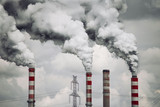Climate Denialism
In 1859, a 39 year-old Irish physicist named John Tyndell was ecstatic to publish the results of his experiments to major European journals. He had proven that carbon dioxide absorbs more heat from the infrared radiation of sunlight than other gasses such as nitrogen, oxygen, and hydrogen. He was finally able to publish his results in 1861, but made no mention of the implications of carbon dioxide’s heat-absorbing ability for the Earth’s climate in his papers.
Despite the recognition that Tyndell received for his experiments, he had already been beaten to this discovery. In 1856, 37 year-old scientist, inventor, and women’s rights activist, Eunice Newton Foote, designed experiments to measure the amount of warming that the sun would induce on different atmospheric conditions. She accomplished this by filling glass jars with differing quantities of gasses and moisture. Her results indicated that carbon dioxide had a greater warming effect than other gasses, and her results were published in The American Journal of Sciences and Arts in 1856 under the title Circumstances affecting the heat of the sun’s rays. Eunice Foote’s work was not properly recognized until 2011, and she is now rightfully credited as the scientist who discovered the greenhouse effect.
Since the official recognition of the greenhouse effect, scientists have come to an ever-stronger consensus that climate change is a real phenomena that is primarily caused by humans. An analysis of 88,125 peer-reviewed scientific papers concluded that between 2012 and 2020 the consensus among scientists that climate change is real and caused by humans was 99.9%. Scientists are overwhelmingly in agreement about climate change, but public opinion polls of American adults show that approximately 30% of the country believes that climate change is not caused by humans, and 16% believe that it is not happening at all. 24% of adults still believe that scientists are not in agreement about global warming.
The divisiveness around the issue of climate change is perpetuated by a phenomenon known as climate change denial, which began in earnest during the 1970’s and 80’s. In 1984, 14 years after the the Environmental Protection Agency (EPA) was established and the National Environmental Policy Act and the Clean Air Act were both signed, president Ronald Reagan gave a radio address to the nation and said “we believe very strongly in the concept of stewardship, caring for the resources we have so they can be shared and used productively for generations to come.” Despite his words, Reagan advocated for the federal government to relinquish ownership of land in the western U.S. to the states so that mining and drilling could take place. He also claimed that information about air pollution and toxic chemical contamination from industries had been highly exaggerated. He was a proponent of deregulating industry and exploiting natural resources to increase profits. During his time as president, climate denialism greatly accelerated. A staunch support for conservative free-market ideologies fueled the resurgence of the conservative movement during his administration.
Environmental regulations put businesses that exploit the Earth at risk of losing profit. Thus, to ensure that operations can keep chugging along, companies fund climate denial efforts to promulgate the message that climate change is not an issue worth spending taxpayer dollars to address. It would be costly for a business that is based on environmentally-destructive production to restructure their operations or change their products for the sake of adhering to environmental regulations. Businesses that do not want to risk losing profits will fight back against legislation that might cost them significant financial losses, and they will often move operations to locations overseas in order to reduce production costs and maximize profit and shareholder value. Sowing doubt about the validity of science is a technique that allows businesses to avoid the hardship of change, because it undermines climate legislation that would threaten their strength in the market. Big tobacco companies in the 1950’s were the first to question the accuracy of science in an effort to maintain profits, and fossil fuel companies later adopted this strategy. Politicians and scientists are paid to find potential inconsistencies, mistakes, or weak points of the published research on climate change and expound the narrative that the science is inconclusive or incomplete.
Among all of the companies committed to climate change denial, ExxonMobil has been the biggest contributor. A document published in 1989 by Exxon’s marketing team titled Greenhouse Science claimed that the science on climate change was unlikely to make any definitive conclusions about the severity of global warming for decades. This material had been published despite warnings about the dangers of the greenhouse effect from scientists who had worked for Exxon. In 1989, Exxon’s in-house climate scientist, Brian Flannery, wrote that “science supports the basic idea that man’s actions pose a serious potential threat to climate.” Exxon knew about the consequences of global warming, but chose to minimize the issue despite the warnings.
Another significant piece of the climate denial machine are conservative think tanks. Corporate America, fossil fuel companies, and conservative foundations all shovel money into think tanks that spew anti-climate rhetoric to the public. The American Enterprise Institute, the Cato Institute, the George C. Marshall Institute, the Heartland Institute, and others are working to push conservative pro-market advertising constantly in order to maintain the interests of large companies. Conservative philanthropists such as Joseph Coors made major financial contributions to conservative think tanks, especially during the 1980’s. Monetary support for these organizations allows them to utilize the media to push their messages in the form of reports, press releases, press conferences, videos, radio and television interviews, etc.
Corporate America, conservative think tanks, and philanthropists have paid scientists to spread doubt about climate change. Fred Singer, a prominent physicist and avid climate denier with connections to big tobacco companies, had spoken avidly about the shakiness of climate change science since the 1990s. Singer also denied the accuracy of science that proved the danger of second-hand smoke, acid rain, and the hole in the ozone layer. In 2013 he spoke at Texas A&M university saying that he had no opinions on the issue of second-hand smoke because his background as a physicist made him unqualified to speak about issues related to chemical toxicology. He said this after the research confirming the danger of secondhand smoke had been well cemented by the scientific community. Scientists who claim that climate science is inadequate give an element of credibility to the climate denial effort, because one would think that the claims of knowledgeable scientists must be accurate and reliable. It is in fact, however, often physicists or scientists who have no background in fields such as environmental science or atmospheric science who propose bold denialist claims about climate change.
Politicians are another huge component of the climate denialism machine. During a press conference held at the White House on June 11th, 2001, president George W. Bush said that his administration was “working to develop an effective and science-based approach to addressing the important issues of global climate change.” In his second week in office, Bush approved the creation of the National Energy Policy Development Group (NEPDG), which issued a report called the National Energy Policy. This report was published four months into Bush’s presidency. Vice president Dick Cheney and the NEPDG met with 300 energy industry officials (including the vice president of ExxonMobil and officials from Bp, and other oil, mining, and gas companies), to discuss strategies for increasing global oil supply and for removing hindrances to the United States’ ability to procure oil. Bush’s administration also rolled back regulations on the fracking industry and glossed over the potential safety risks associated with fracking and the cleanliness of drinking water. In addition to Bush and Cheney, Oklahoma senator James Inhofe was another prominent political opponent of climate change action. He claimed that climate change was “the greatest hoax ever perpetrated on the American people,” and that the EPA was a “Gestapo bureaucracy.”
Climate denialists have even expounded the claim that rising CO2 levels would actually be healthy for the planet. Two videos produced by the “Greening Earth Society” were released in the 1990’s claiming that higher levels of CO2 would lead to larger and greener vegetation because plants intake CO2 in order to produce glucose. This has since been disproven by scientists who have measured the effects of warmer climates on crop yields, and have found that heat level rise, wildfires, insect population growth, a proliferation of weeds, and a greater frequency of livestock diseases would actually reduce vegetation growth overall. Members of the “Greening Earth Society” were all connected to the coal and fossil fuel industries. The videos used footage of U.S. government scientists that had been edited to make it sound as if they were stating that CO2 emissions were actually healthy for the planet. The scientists have since clarified that their comments were taken out of context.
Climate denialism is perpetuated by large corporations that stand to lose a strong economic stance in the market if climate regulations are enacted. The ideologies of uninhibited market growth and deregulation of business are the backbone of climate denialism. If an industry sees profits in the exploitation of the Earth, it would be advantageous for them to undermine climate legislation that would hinder their activities. Fossil fuel companies, conservative think tanks, and contrarian scientists with financial stakes in the combustible energy market are all major players in the climate denial machine. Deniers claim that climate science is uncertain, that the issue isn’t real or serious, that climate change is not caused by human activity, or even that more CO2 would actually be good for the planet. To avoid the narratives of climate denialism, readers can reference the websites listed below, which provide credible climate change information. It is important to remember that scientists are in firm agreement that climate change is real, and that humans are primarily causing it. Accepting these facts are the first step towards making real, lasting environmental change.
Websites for accurate information about climate change
https://www.un.org/en/climatechange/
Recent Posts
-
Air Quality Conundrum in Delhi and the Challenges of Environmental Science
The headline of a story published on CBS news on November 14th of this year read that residents of t …Dec 3rd 2024 -
The Importance of Environmental Engineering
In 1854, John Snow (no, not the Game of Thrones character), a physician investigating cholera outbre …Nov 26th 2024 -
A Sustainable and Ethical Thanksgiving
The story of the first Thanksgiving is commonly portrayed as a time when friendly Indians greeted th …Nov 25th 2024




